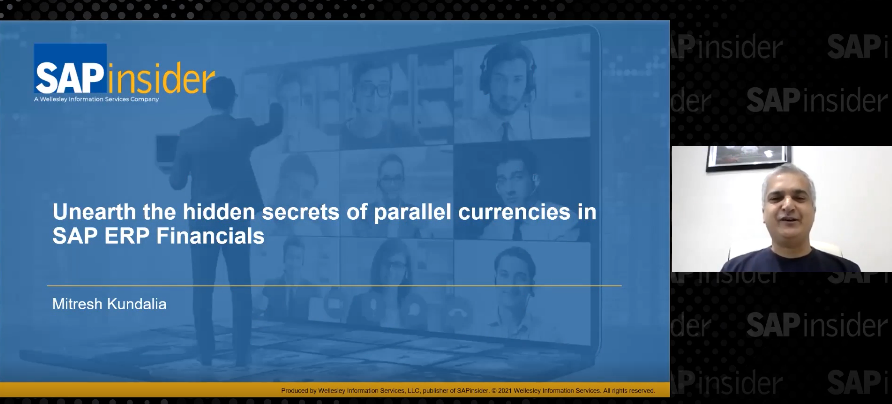How Will Digital Transformation Impact Your SAP Financials Processes?
Live Q&A with international financial experts
In this Q&A session experts share strategic advice on how visionary companies optimize and automate finance processes to enable fast, accurate, and compliant financial decisions.
If you missed the chat or need a refresher, we welcome you to view the online chat replay or read the edited transcript below.
Meet the panelists:
 Tom Walker is the OpenText Senior Program Manager in the SAP Finance Center of Excellence with primary responsibility for SAP Invoice Management, Tom has assisted numerous Fortune 500 companies in the optimization and automation of their worldwide SAP processes. He is a frequent speaker at SAP Sapphire and Americas SAP User Group meetings.
Tom Walker is the OpenText Senior Program Manager in the SAP Finance Center of Excellence with primary responsibility for SAP Invoice Management, Tom has assisted numerous Fortune 500 companies in the optimization and automation of their worldwide SAP processes. He is a frequent speaker at SAP Sapphire and Americas SAP User Group meetings.
He has worked with SAP software for over 20 years. His financial experience includes cost accounting, accounts payable, general accounting, financial analysis, auditing and management.
 Matthias Niessen manages the OpenText Center of Financial and Procurement Excellence in EMEA and APJ. He has a background in Engineering, Product Management and Business Consulting and over 18 years of combined experience in the SAP and ECM market spaces.
Matthias Niessen manages the OpenText Center of Financial and Procurement Excellence in EMEA and APJ. He has a background in Engineering, Product Management and Business Consulting and over 18 years of combined experience in the SAP and ECM market spaces.
 Ravi Pitchika is Senior Director of Global Services at OpenText. He is responsible for implementing SAP products that OpenText develops. He was head of R&D for more than 12 years that was responsible for developing several of SAP add-on products at OpenText. For the last 5 years he is focused on helping large global customers optimize their Accounts Payable and other mission-critical processes using OpenText and SAP technologies.
Ravi Pitchika is Senior Director of Global Services at OpenText. He is responsible for implementing SAP products that OpenText develops. He was head of R&D for more than 12 years that was responsible for developing several of SAP add-on products at OpenText. For the last 5 years he is focused on helping large global customers optimize their Accounts Payable and other mission-critical processes using OpenText and SAP technologies.
Transcript:
SAPinsiderMatt: Welcome to today’s Q&A on how digital transformation will impact your SAP financials processes. I am pleased to be joined by international financial experts from OpenText!
Please welcome Tom Walker, Senior Program Manager, SAP Finance CoE, Matthias Niessen, Financial and Procurement CoE, and Ravi Pitchika, Senior Director of Global Services.
There are already a number of questions posted. Please enter your questions into the module below to ensure the experts have a chance to answer it during the hour.
Matthias Nießen: Thanks Matt, I’m happy to be here. And thanks everyone for your participation. I look forward to the discussion.
Tom Walker: Thank you, Matt. We are looking forward to some great questions. We appreciate everyone taking time in their busy days to share their questions.
Comment From Chris: What are the top 5 impact outcomes on your SAP financials process created by digital transformation efforts?
Tom Walker: Accuracy of financial statements, cost reduction, informed financial decisions, generation of additional revenue, and improved dispute management.
Comment From nitesh: How is the costing process impacted in a typical manufacturing organization?
Tom Walker: COGS accuracy is improved through controlled P2P. Allocations approvals are documented, proper accruals are realized, and the costing process is controlled and documented.
Comment From kumara: Please provide some more details about SAP Financials.
Tom Walker: SAP Financials is about obtaining both one source of the truth and one source of the supporting documentation, which is needed with financial information. SAP Financials provides information that is timely, accurate, and relevant (TAR).
https://go.sap.com/solution/lob/finance/s4hana-finance-erp.html
Comment From nitesh: What are your thoughts on the ways decision makers will evaluate their product, division, and geographical performance results, e.g. profitability, with the evolution of S/4HANA?
Tom Walker: Shared services is a trend that is growing. Use of centralized data will provide enterprises with trend analysis. S/4HANA allows real time global comparisons. Another evolution that has brought about greater processing speed and depth of data is predictive analytics.
Comment From Brijesh: Maybe a naive question here, but what do you mean/intend by “digital transformation”?
Ravi Pitchika: Brijesh – the key aspects of what companies are trying to do with the “digital transformation” is to capitalize on the all the capabilities made available by moving away from paper as well as all the progress to by gaining by having big data in a consumable and usable form to make efficient business decisions. An example is how you can make accounts payable entirely digital even though you get some documents in paper format.
Comment From Oisin: What are some key considerations when defining workflow processes?
Ravi Pitchika: Great question Oisin. the key things to note include:
1. Simplifying the process instead of automating a manual, inefficient process
2. Talking to all the key stakeholders to define an optimal process
3. Leveraging technology that makes it simpler for process participants to engage
Comment From Jeanne: What are the factors to consider when setting up shared service centers for finance?
Ravi Pitchika: Hi Jeanne. The key considerations are:
1. A well-defined process flow
2. Accountable and auditable processes
3. Key metrics and reporting on SLAs and overall efficiency
Comment From Alex: Can you mention key best practices that we should adhere to when streamlining SAP financials processes?
Tom Walker: We have found that the cornerstone of best practice is to analyze and optimize the process before automation. It is key to involve key stakeholders early on in redesign. It is also critical that your technical team has an understanding of the business process, not just the coding.
Comment From Josh: What are the key trends that you have observed in the enterprise finance industry globally and regionally?
Tom Walker: The Use of shared services, the purging of master data, improved record retention, mobility (Fiori), and standardization.
Comment From Alex: What have you seen finance organizations do to thrive in the new digital economy?
Matthias Nießen: Hi Alex, thanks for participating.
The digital economy creates some new challenges for finance: You need to have much better customer intimacy and adapt to new processes. Today, finance organizations are focusing not only on numbers but also on the business context. With the right content in context, it is much easier to make the right decisions and to accommodate proper business planning.
Comment From Arto: How would you migrate ERP, which has transactions that are not yet native in S/4? Should those systems use old DB schema, if so, how do you later get them onto native HANA?
Ravi Pitchika: Hi Arto. The key to ensuring you have a successful migration from ERP to S/4 is to analyze your business requirements and map them to the functionality that is baseline in S/4. And if there are true gaps, build that functionality by factoring in HANA DB, which can provide a much more efficient solution and then building front-end in Fiori or in other UI as appropriate. At the end of the day S/4 is also primarily an ABAP stack-based system, so you should be able to leverage most of the skills of your team with some training.
Comment From Param: How can SAP can help showcase a positive differential through digitalization that would help pharma customers in finalizing financial deals with third parties?
Ravi Pitchika: Hi Param. Digitization is obviously cross-vertical, but specific to Pharma and other especially regulated industries, having a digital platform that can manage both structured data (in HANA) and unstructured data in documents and other artifacts is key. Doing it in the context of the business transactions will be a key success factor. You can accomplish that with the S/4 platform and Extended ECM, which is sold by SAP.
Comment From Param: Thanks Ravi for your reply to Oisin’s query. However, it seems a bit generic. Is it possible to elaborate with an example? It would help all others, too.
Ravi Pitchika: Absolutely. Take the case of setting up an approval process for supplier invoices. If you encapsulate a very complex approval process within complex UI with all the data fields that are rarely used, the result would be a clunky process that business users dislike. On the other hand, if you work with the business stakeholders to define a relatively simple process (though with appropriate controls and a simple UI either on Fiori or even in WebGui) you will get better reception from the user base and you will accomplish your business needs better.
Comment From Jean-Yves Bildstein: Could you please describe the digital transformation impact on financial shared services? Does the digital transformation eliminate the “low-level” activities (eg. scanning, data loads, reconciliation), allowing the shared services to handle more value-added activities?
Tom Walker: Effective SS requires fast informed, decisions. Digitization of transactional and supporting data provides knowledge at a click. We find paper is still significant so at some point scanning and data loads remain, but these are often moved to different skill sets. Optimization and automation handles much of the error detection and provides immediate communication along with suggested resolutions.
Comment From Brijesh: Just a comment: The headline to me suggests that you are transforming the processes when the company has already implemented the SAP systems, sort of creating a version 2.0 of the processes.
Ravi Pitchika: Good point. Implementing SAP is the first step, but to fully capitalize on it you do have to put in effort to bring other content into the purview of a controlled system.
Comment From Chris: We are working with DOD government agencies that are preparing for financial audits. What can the OpenText Extended ECM for SAP solution do to put the DOD agencies in a stronger position to pass the pending financial audits?
Matthias Nießen: Hi Chris,
Extended ECM allows you to create workspaces attached to any business object. This allows auditors full access to any documentation/justification of payments and decisions made. This also includes audit trails for processes, e.g. approvals for certain postings.
Read more: https://www.opentext.com/what-we-do/products/opentext-suite-for-sap/opentext-extended-ecm-for-sap-solutions
Comment From Tom: In an organization that is becoming more SSC-centric, how can S4/ HANA technology enhance a potential robotics lead process environment?
Ravi Pitchika: Hi Tom. S/4 can help in a number of ways:
1. Simplifying the data models to ensure SSC-based processes run efficiently
2. Optimizing business processes by using products like Digital Content Processing (DCP) to streamline process flows
3. Providing actionable analytics powered by HANA, which can build quickly
4. Providing a Bbautiful UI to engage process participants with Fiori
Comment From Ken: Is it feasible or recommended to migrate to a private, managed S/4HANA cloud instance for core finance, yet keep some ancillary financial processes on-premise in a phased rollout?
Tom Walker: My initial response is the one answer we all don’t what to hear…”it depends”. From my discussions with corporations, many are adopting a hybrid approach. S/4HANA provides real financial improvement cloud or on premise. I think it often comes down to a decision based on sensitive information and security when making the decision on where to run financial processes.
Comment From Arto: Do you have any general idea of how much faster period end closing would be with HANA when compared to ERP and BW?
Ravi Pitchika: Hi Arto. Since the data model is much simpler in S4 and also because of the HANA DB, you should expect to see performance that is several orders better than ERP and BW.
Comment From Mark: Should we start using SAP Fiori right now?
Matthias Nießen: Hi Mark. Look at Fiori 2.0, which was recently released. The new overview pages are just great and compelling. And you can still embed Web UI into the launchpad if you need the broader functionality available in SAP GUI.
Comment From Ken: What is the central journal deployment option, and how do I know if it’s right for my organization?
Ravi Pitchika: Hi Ken. With S4 there was significant overall change of all the architecture around all journal-related functionality and the underlying data model. I suggest having your FI functional analyst review S4 documentation and potentially go to some SAP training to get a deeper understanding of the functionality and do an analysis before deciding. The overall paradigm around how all the accounting entries are recorded has changed significantly.
Comment From Bianca: When moving to SAP S/4HANA, what do I do about all the financial support documentation?
Ravi Pitchika: Hi Bianca. Depending on where you are currently storing the supporting documentation (I am guessing you are referring to invoice images, contracts, etc.), you can relink them in S4. If you are already using an SAP ArchiveLink-compliant Repository like OpenText, those links will migrate automatically. There were not too many changes to ArchiveLink that were done by SAP.
Comment From Tom: Thanks, Ravi. 2 questions to follow up: 1) Can you elaborate a bit more on DCP? 2) Fiori UI is present in SAP Fraud and Audit Management software, correct?
Tom Walker: This is Tom responding to Tom. Digital Content Processing (DCP) is a solution that is utilized to capture relevant metadata from any document based on OCR. True digitization eliminates the manual, error-prone data entry. DCP also integrates with access to all forms of supporting documentation and provides validation as well as communication solutions. DCP is based on Fiori UI. SAP’s stated path forward for UI is Fiori for all solutions.
Comment From Greg: Do you see EDI continuing to be relevant with the push of networks?
Tom Walker: Yes, I see EDI being relevant in the future. Networks and EDI both have their value in the business chain. EDI is a proven, trusted, and deeply developed solution. Many corporations have significant interactions with primary trading partners through EDI.
Comment From Jean-Yves Bildstein: With SAP BPC embedded into SAP S/4HANA Finance, are there still benefits to using SAP BW for reporting ?
Ravi Pitchika: Good question. The answer is “it depends”. S4 does include a whole suite of reporting and planning tools. I suggest you evaluate if BPC can meet your requirements. If so, you can eliminate BW.
Comment From Veekay: How does all this digital transformation changed data warehousing and BW usage with S/4HANA?
Matthias Nießen: Hi Veekay. The new digital core combines transactional and analytical capabilities. This allows data analysis in real time, as opposed to close to real time reports in BW. Certain reports will continue to be used in BW for a while, but the appetite for live data is definitely an important driver for S/4HANA adoption.
Comment From John: With SAP S/4HANA, soft close is mentioned frequently. What are some key elements digitization will impact?
Tom Walker: Soft closings are intended to provide immediate financial info. S/4HANA now has the ability to include a lot of information typically omitted during a “manual” soft close. Also, the speed provided allows for effective roll up of cost. Keep in mind that this still requires access to all supporting documentation.
Tom Walker: Thank you for your time and questions. We are all in information overload due to the depth of data available, but for financial professionals, the debits and credits must always be timely, accurate, relevant, and supported. We wish you great success in your digital financial journey.
Ravi Pitchika: In closing, there are a couple of key insights that I want to mention:
1. Digitization was always there – but the big difference is the scale and toolset that is now available to achieve it.
2. User service consumption trends have changed. The end users are no longer OK with dealing with dated UI.
SAPinsiderMatt: Thank you Tom, Ravi, and Matthias for all your insightful answers. And thank you to everyone who participated in today’s Q&A! You can review the Q&A chat replay at any time, and I will alert you by email you when the transcript of today’s discussion is posted.
In this Q&A session experts share strategic advice on how visionary companies optimize and automate finance processes to enable fast, accurate, and compliant financial decisions.
If you missed the chat or need a refresher, we welcome you to view the online chat replay or read the edited transcript below.
Meet the panelists:
 Tom Walker is the OpenText Senior Program Manager in the SAP Finance Center of Excellence with primary responsibility for SAP Invoice Management, Tom has assisted numerous Fortune 500 companies in the optimization and automation of their worldwide SAP processes. He is a frequent speaker at SAP Sapphire and Americas SAP User Group meetings.
Tom Walker is the OpenText Senior Program Manager in the SAP Finance Center of Excellence with primary responsibility for SAP Invoice Management, Tom has assisted numerous Fortune 500 companies in the optimization and automation of their worldwide SAP processes. He is a frequent speaker at SAP Sapphire and Americas SAP User Group meetings.
He has worked with SAP software for over 20 years. His financial experience includes cost accounting, accounts payable, general accounting, financial analysis, auditing and management.
 Matthias Niessen manages the OpenText Center of Financial and Procurement Excellence in EMEA and APJ. He has a background in Engineering, Product Management and Business Consulting and over 18 years of combined experience in the SAP and ECM market spaces.
Matthias Niessen manages the OpenText Center of Financial and Procurement Excellence in EMEA and APJ. He has a background in Engineering, Product Management and Business Consulting and over 18 years of combined experience in the SAP and ECM market spaces.
 Ravi Pitchika is Senior Director of Global Services at OpenText. He is responsible for implementing SAP products that OpenText develops. He was head of R&D for more than 12 years that was responsible for developing several of SAP add-on products at OpenText. For the last 5 years he is focused on helping large global customers optimize their Accounts Payable and other mission-critical processes using OpenText and SAP technologies.
Ravi Pitchika is Senior Director of Global Services at OpenText. He is responsible for implementing SAP products that OpenText develops. He was head of R&D for more than 12 years that was responsible for developing several of SAP add-on products at OpenText. For the last 5 years he is focused on helping large global customers optimize their Accounts Payable and other mission-critical processes using OpenText and SAP technologies.
Transcript:
SAPinsiderMatt: Welcome to today’s Q&A on how digital transformation will impact your SAP financials processes. I am pleased to be joined by international financial experts from OpenText!
Please welcome Tom Walker, Senior Program Manager, SAP Finance CoE, Matthias Niessen, Financial and Procurement CoE, and Ravi Pitchika, Senior Director of Global Services.
There are already a number of questions posted. Please enter your questions into the module below to ensure the experts have a chance to answer it during the hour.
Matthias Nießen: Thanks Matt, I’m happy to be here. And thanks everyone for your participation. I look forward to the discussion.
Tom Walker: Thank you, Matt. We are looking forward to some great questions. We appreciate everyone taking time in their busy days to share their questions.
Comment From Chris: What are the top 5 impact outcomes on your SAP financials process created by digital transformation efforts?
Tom Walker: Accuracy of financial statements, cost reduction, informed financial decisions, generation of additional revenue, and improved dispute management.
Comment From nitesh: How is the costing process impacted in a typical manufacturing organization?
Tom Walker: COGS accuracy is improved through controlled P2P. Allocations approvals are documented, proper accruals are realized, and the costing process is controlled and documented.
Comment From kumara: Please provide some more details about SAP Financials.
Tom Walker: SAP Financials is about obtaining both one source of the truth and one source of the supporting documentation, which is needed with financial information. SAP Financials provides information that is timely, accurate, and relevant (TAR).
https://go.sap.com/solution/lob/finance/s4hana-finance-erp.html
Comment From nitesh: What are your thoughts on the ways decision makers will evaluate their product, division, and geographical performance results, e.g. profitability, with the evolution of S/4HANA?
Tom Walker: Shared services is a trend that is growing. Use of centralized data will provide enterprises with trend analysis. S/4HANA allows real time global comparisons. Another evolution that has brought about greater processing speed and depth of data is predictive analytics.
Comment From Brijesh: Maybe a naive question here, but what do you mean/intend by “digital transformation”?
Ravi Pitchika: Brijesh – the key aspects of what companies are trying to do with the “digital transformation” is to capitalize on the all the capabilities made available by moving away from paper as well as all the progress to by gaining by having big data in a consumable and usable form to make efficient business decisions. An example is how you can make accounts payable entirely digital even though you get some documents in paper format.
Comment From Oisin: What are some key considerations when defining workflow processes?
Ravi Pitchika: Great question Oisin. the key things to note include:
1. Simplifying the process instead of automating a manual, inefficient process
2. Talking to all the key stakeholders to define an optimal process
3. Leveraging technology that makes it simpler for process participants to engage
Comment From Jeanne: What are the factors to consider when setting up shared service centers for finance?
Ravi Pitchika: Hi Jeanne. The key considerations are:
1. A well-defined process flow
2. Accountable and auditable processes
3. Key metrics and reporting on SLAs and overall efficiency
Comment From Alex: Can you mention key best practices that we should adhere to when streamlining SAP financials processes?
Tom Walker: We have found that the cornerstone of best practice is to analyze and optimize the process before automation. It is key to involve key stakeholders early on in redesign. It is also critical that your technical team has an understanding of the business process, not just the coding.
Comment From Josh: What are the key trends that you have observed in the enterprise finance industry globally and regionally?
Tom Walker: The Use of shared services, the purging of master data, improved record retention, mobility (Fiori), and standardization.
Comment From Alex: What have you seen finance organizations do to thrive in the new digital economy?
Matthias Nießen: Hi Alex, thanks for participating.
The digital economy creates some new challenges for finance: You need to have much better customer intimacy and adapt to new processes. Today, finance organizations are focusing not only on numbers but also on the business context. With the right content in context, it is much easier to make the right decisions and to accommodate proper business planning.
Comment From Arto: How would you migrate ERP, which has transactions that are not yet native in S/4? Should those systems use old DB schema, if so, how do you later get them onto native HANA?
Ravi Pitchika: Hi Arto. The key to ensuring you have a successful migration from ERP to S/4 is to analyze your business requirements and map them to the functionality that is baseline in S/4. And if there are true gaps, build that functionality by factoring in HANA DB, which can provide a much more efficient solution and then building front-end in Fiori or in other UI as appropriate. At the end of the day S/4 is also primarily an ABAP stack-based system, so you should be able to leverage most of the skills of your team with some training.
Comment From Param: How can SAP can help showcase a positive differential through digitalization that would help pharma customers in finalizing financial deals with third parties?
Ravi Pitchika: Hi Param. Digitization is obviously cross-vertical, but specific to Pharma and other especially regulated industries, having a digital platform that can manage both structured data (in HANA) and unstructured data in documents and other artifacts is key. Doing it in the context of the business transactions will be a key success factor. You can accomplish that with the S/4 platform and Extended ECM, which is sold by SAP.
Comment From Param: Thanks Ravi for your reply to Oisin’s query. However, it seems a bit generic. Is it possible to elaborate with an example? It would help all others, too.
Ravi Pitchika: Absolutely. Take the case of setting up an approval process for supplier invoices. If you encapsulate a very complex approval process within complex UI with all the data fields that are rarely used, the result would be a clunky process that business users dislike. On the other hand, if you work with the business stakeholders to define a relatively simple process (though with appropriate controls and a simple UI either on Fiori or even in WebGui) you will get better reception from the user base and you will accomplish your business needs better.
Comment From Jean-Yves Bildstein: Could you please describe the digital transformation impact on financial shared services? Does the digital transformation eliminate the “low-level” activities (eg. scanning, data loads, reconciliation), allowing the shared services to handle more value-added activities?
Tom Walker: Effective SS requires fast informed, decisions. Digitization of transactional and supporting data provides knowledge at a click. We find paper is still significant so at some point scanning and data loads remain, but these are often moved to different skill sets. Optimization and automation handles much of the error detection and provides immediate communication along with suggested resolutions.
Comment From Brijesh: Just a comment: The headline to me suggests that you are transforming the processes when the company has already implemented the SAP systems, sort of creating a version 2.0 of the processes.
Ravi Pitchika: Good point. Implementing SAP is the first step, but to fully capitalize on it you do have to put in effort to bring other content into the purview of a controlled system.
Comment From Chris: We are working with DOD government agencies that are preparing for financial audits. What can the OpenText Extended ECM for SAP solution do to put the DOD agencies in a stronger position to pass the pending financial audits?
Matthias Nießen: Hi Chris,
Extended ECM allows you to create workspaces attached to any business object. This allows auditors full access to any documentation/justification of payments and decisions made. This also includes audit trails for processes, e.g. approvals for certain postings.
Read more: https://www.opentext.com/what-we-do/products/opentext-suite-for-sap/opentext-extended-ecm-for-sap-solutions
Comment From Tom: In an organization that is becoming more SSC-centric, how can S4/ HANA technology enhance a potential robotics lead process environment?
Ravi Pitchika: Hi Tom. S/4 can help in a number of ways:
1. Simplifying the data models to ensure SSC-based processes run efficiently
2. Optimizing business processes by using products like Digital Content Processing (DCP) to streamline process flows
3. Providing actionable analytics powered by HANA, which can build quickly
4. Providing a Bbautiful UI to engage process participants with Fiori
Comment From Ken: Is it feasible or recommended to migrate to a private, managed S/4HANA cloud instance for core finance, yet keep some ancillary financial processes on-premise in a phased rollout?
Tom Walker: My initial response is the one answer we all don’t what to hear…”it depends”. From my discussions with corporations, many are adopting a hybrid approach. S/4HANA provides real financial improvement cloud or on premise. I think it often comes down to a decision based on sensitive information and security when making the decision on where to run financial processes.
Comment From Arto: Do you have any general idea of how much faster period end closing would be with HANA when compared to ERP and BW?
Ravi Pitchika: Hi Arto. Since the data model is much simpler in S4 and also because of the HANA DB, you should expect to see performance that is several orders better than ERP and BW.
Comment From Mark: Should we start using SAP Fiori right now?
Matthias Nießen: Hi Mark. Look at Fiori 2.0, which was recently released. The new overview pages are just great and compelling. And you can still embed Web UI into the launchpad if you need the broader functionality available in SAP GUI.
Comment From Ken: What is the central journal deployment option, and how do I know if it’s right for my organization?
Ravi Pitchika: Hi Ken. With S4 there was significant overall change of all the architecture around all journal-related functionality and the underlying data model. I suggest having your FI functional analyst review S4 documentation and potentially go to some SAP training to get a deeper understanding of the functionality and do an analysis before deciding. The overall paradigm around how all the accounting entries are recorded has changed significantly.
Comment From Bianca: When moving to SAP S/4HANA, what do I do about all the financial support documentation?
Ravi Pitchika: Hi Bianca. Depending on where you are currently storing the supporting documentation (I am guessing you are referring to invoice images, contracts, etc.), you can relink them in S4. If you are already using an SAP ArchiveLink-compliant Repository like OpenText, those links will migrate automatically. There were not too many changes to ArchiveLink that were done by SAP.
Comment From Tom: Thanks, Ravi. 2 questions to follow up: 1) Can you elaborate a bit more on DCP? 2) Fiori UI is present in SAP Fraud and Audit Management software, correct?
Tom Walker: This is Tom responding to Tom. Digital Content Processing (DCP) is a solution that is utilized to capture relevant metadata from any document based on OCR. True digitization eliminates the manual, error-prone data entry. DCP also integrates with access to all forms of supporting documentation and provides validation as well as communication solutions. DCP is based on Fiori UI. SAP’s stated path forward for UI is Fiori for all solutions.
Comment From Greg: Do you see EDI continuing to be relevant with the push of networks?
Tom Walker: Yes, I see EDI being relevant in the future. Networks and EDI both have their value in the business chain. EDI is a proven, trusted, and deeply developed solution. Many corporations have significant interactions with primary trading partners through EDI.
Comment From Jean-Yves Bildstein: With SAP BPC embedded into SAP S/4HANA Finance, are there still benefits to using SAP BW for reporting ?
Ravi Pitchika: Good question. The answer is “it depends”. S4 does include a whole suite of reporting and planning tools. I suggest you evaluate if BPC can meet your requirements. If so, you can eliminate BW.
Comment From Veekay: How does all this digital transformation changed data warehousing and BW usage with S/4HANA?
Matthias Nießen: Hi Veekay. The new digital core combines transactional and analytical capabilities. This allows data analysis in real time, as opposed to close to real time reports in BW. Certain reports will continue to be used in BW for a while, but the appetite for live data is definitely an important driver for S/4HANA adoption.
Comment From John: With SAP S/4HANA, soft close is mentioned frequently. What are some key elements digitization will impact?
Tom Walker: Soft closings are intended to provide immediate financial info. S/4HANA now has the ability to include a lot of information typically omitted during a “manual” soft close. Also, the speed provided allows for effective roll up of cost. Keep in mind that this still requires access to all supporting documentation.
Tom Walker: Thank you for your time and questions. We are all in information overload due to the depth of data available, but for financial professionals, the debits and credits must always be timely, accurate, relevant, and supported. We wish you great success in your digital financial journey.
Ravi Pitchika: In closing, there are a couple of key insights that I want to mention:
1. Digitization was always there – but the big difference is the scale and toolset that is now available to achieve it.
2. User service consumption trends have changed. The end users are no longer OK with dealing with dated UI.
SAPinsiderMatt: Thank you Tom, Ravi, and Matthias for all your insightful answers. And thank you to everyone who participated in today’s Q&A! You can review the Q&A chat replay at any time, and I will alert you by email you when the transcript of today’s discussion is posted.








